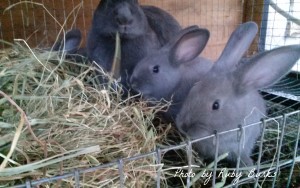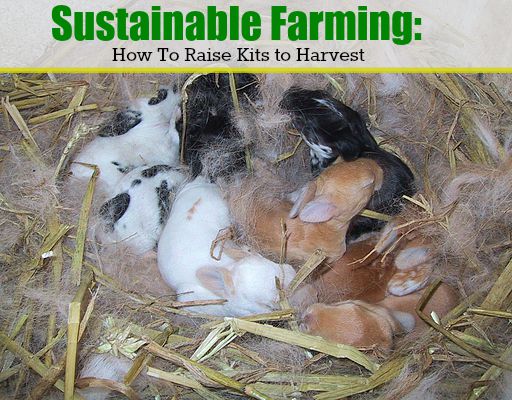
Optimal Production
As we discussed in the first article in this series, the feed to meat ratio (also known as the feed conversion ratio/rate or FCR) is extremely important to the successful production of rabbit meat. FCR is a measurement of the animal’s ability to convert feed mass into the desired output- in this case, meat. Care should be taken to reduce the FCR as much as possible to insure the most efficient meat production.
Meat production breeds provide the best choice for low FCR. Tracking the progress of your litters with careful documentation on the Doe Breeding Chart provided in the second article of this series will help you determine which rabbits within your breeding stock are providing the lowest FCR and which should be culled.
Day Zero to Ten
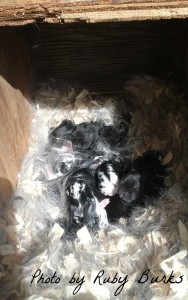 Assuming proper breed selection, breeder stock maintenance, and optimal housing have been provided, caring for a litter of kits is relatively easy. During the first week post-kindle, the doe does most of the work. Care should be taken to check the nest boxes daily. Remove any dead kits from the nest box during this time since the doe will not remove them and regroup the litter together if any kits get isolated into a corner or away from their littermates. The nesting material should be checked daily to insure it remains free of debris and replaced as needed. It may be necessary to add extra bedding during the winter to insure adequate warmth for the kits.
Assuming proper breed selection, breeder stock maintenance, and optimal housing have been provided, caring for a litter of kits is relatively easy. During the first week post-kindle, the doe does most of the work. Care should be taken to check the nest boxes daily. Remove any dead kits from the nest box during this time since the doe will not remove them and regroup the litter together if any kits get isolated into a corner or away from their littermates. The nesting material should be checked daily to insure it remains free of debris and replaced as needed. It may be necessary to add extra bedding during the winter to insure adequate warmth for the kits.
The doe should be fed twelve to sixteen ounces of feed for three to five days after kindling and then free feed until the kits are weaned to compensate for milk production. Water should be available to her at all times. The importance of water can’t be stressed enough. Water is essential for the does milk production and nutrient intake. A doe that is low or lacking water will reduce her feed intake and the feed that she does eat won’t be converted to energy as efficiently. This will result in reduced milk production or milk of lesser quality, both of which impact the growth of the kits and the health of the doe.
Fostering kits on another doe that recently kindled may be necessary during this time. Orphaned kits and kits that have been rejected by their birth doe are candidates for fostering. It’s possible to hand-raise kits, but the success rate is low, the kits will have very high FCR, and it is time-consuming. The best time to introduce foster kits to a foster doe is during the first 48 hours after kindle. Fostering can be attempted after this time, but the chances that the doe will reject the kits and kill them (and quite possibly kill the kits she gave birth to, also) increases with each passing day.
It’s not uncommon for first-time does to reject, cannibalize, or otherwise lose their litters. First time does should be bred again, but if litter losses continue with the second litter, the doe should be culled. If a doe loses all her litter at kindling, rebreed her three days later. If she loses all her litter after several days, she can be rebred immediately.
Occasionally kits will get accidentally pulled out of the nest box during nursing in the first ten days or will jump out and be unable to find it’s way back in. If this happens, put the kit back in the nest box as soon as possible. The doe will not do this and the kit can die quickly from exposure or missed feedings. An exposed kit is a stressed kit and stress reduces weight gain.
Day Ten to Eighteen
Kits will begin to open their eyes around ten days old and all the kits in the litter should have their eyes open by twelve days old. Nest Box Eye should be suspected in any kit that hasn’t opened its eyes by the twelfth day. Nest Box Eye is a common bacterial infection in kits and is typically caused by unsanitary conditions in the nest box or by kits burrowing deep into the nest box to stay warm during the winter and sleeping low in the nest where they are more likely to come in contact with soiled bedding. Removing and replacing soiled bedding during the first ten days greatly reduces the chances your kits’ eyes will become infected. Providing deep bedding in the nest box during the winter allows the kits to burrow deep enough to stay warm, but high enough off the floor of the nest box to avoid any soiled bedding.
Never force a kit’s eyes open! Not only can this cause more injury, it’s also painful to the kit. The risk of Nest Box Eye greatly increases when the kits reach twelve to eighteen days old. If you suspect a kit has Nest Box Eye, sometimes the best treatment is to remove exposure to the bacteria either by thoroughly cleaning the nest box or by removing it altogether and allowing the infection to clear on its own. In some cases, it may be necessary to treat the infection either with Terramycin ophthalmic ointment or by gently applying a warm compress (not too hot!) soaked with saline solution or chamomile tea.
Depending on the season, the nest box should be removed completely once the kits are about eighteen days old. If the nest box is left in longer, the kits will start soiling it with feces and urine. Continue to offer free choice feed to the doe and plenty of fresh, clean water. During this time, the kits are still getting the majority of their nutrients from nursing, but will start experimenting with the feed and water bottle.
Day Eighteen to Twenty-Eight
 From day eighteen to twenty-eight, the kits will continue to increase their food and water consumption. They become much more active and mobile, sometimes to the point of soiling their feeder. Keep an eye on your feeder to make sure they aren’t defecating in it. They’re also more likely to waste feed at this time by digging and playing in it. Since feed is the greatest cost in rabbit production, it’s important to minimize loss due to it becoming soiled or spilled. This is a good time to assess your feed containers and improve on them. Metal feed hoppers with a mesh bottom are by far the most efficient, but they may not always be available. If crocks are used, they should be heavy enough to prevent the active, bouncy kits from tipping them over and spilling all your expensive feed on the floor. Rabbits will not eat dirty feed. If feeding hay and garden scraps, it may become necessary to feed multiple times a day to keep the kits from playing in or on their food and ruining it. However, no matter which method you chose, it is still important that they and the doe have an abundant supply.
From day eighteen to twenty-eight, the kits will continue to increase their food and water consumption. They become much more active and mobile, sometimes to the point of soiling their feeder. Keep an eye on your feeder to make sure they aren’t defecating in it. They’re also more likely to waste feed at this time by digging and playing in it. Since feed is the greatest cost in rabbit production, it’s important to minimize loss due to it becoming soiled or spilled. This is a good time to assess your feed containers and improve on them. Metal feed hoppers with a mesh bottom are by far the most efficient, but they may not always be available. If crocks are used, they should be heavy enough to prevent the active, bouncy kits from tipping them over and spilling all your expensive feed on the floor. Rabbits will not eat dirty feed. If feeding hay and garden scraps, it may become necessary to feed multiple times a day to keep the kits from playing in or on their food and ruining it. However, no matter which method you chose, it is still important that they and the doe have an abundant supply.
Death from enteritis (inflammation of the intestines) increases during their transition from nursing to solid foods and continues through weaning or until they are about two months old. Sometimes the kits will exhibit diarrhea and sometimes they have no symptoms at all. In other farm animals, enteritis is known as scours.
Enteritis is caused by a bacterial build-up in the intestines. Reducing stress on your herd, feeding a well-balanced and consistent diet with clean fresh water, and clean living conditions greatly enhances the rabbits’ natural immune system. However, in severe cases, it may become necessary to treat with antibiotics and/or probiotics.
Day Twenty-Eight to Harvest
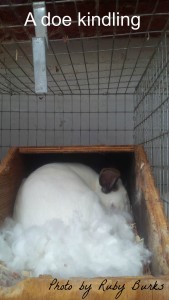 After kits reach twenty-eight days (roughly four weeks), they can be safely weaned provided they are completely able to feed themselves. Once weaned, they’re called fryers until they reach twelve weeks old.
After kits reach twenty-eight days (roughly four weeks), they can be safely weaned provided they are completely able to feed themselves. Once weaned, they’re called fryers until they reach twelve weeks old.
If the cage-method of raising rabbits has been chosen, there are three choices for weaning kits: remove the doe and leave the kits in the cage they were born in, remove the kits to a grow-out pen and leave the doe, leave the kits with the doe and grow them out in place. There are pros and cons to each method.
Some feel that leaving the kits and removing the does causes less stress on the kits during a time when the risk of them developing enteritis is greatest. However, this means you’ll need a lot more cage space for all the does you’re moving.
Some feel removing the kits and leaving the does has a marginal impact on the kits and is less stressful on the doe, thereby increasing her fertility and productivity.
Some feel leaving the kits with the doe until harvest is the “Goldilocks” of choices- neither too stressful on the kits nor too stressful on the doe, and a balance of “just right”. It also requires less cages since you won’t need additional cages to move the does or the kits into during the grow-out phase. The downside to this method is the inability to rebreed fourteen or twenty-one days after kindle, a reduction is the number of litters per year your doe will be able to have, and the possibility that your doe will become weary of motherhood and start abusing her kits in an effort to get away from their constant demands.
So which is the best method to choose? The answer is…the one that works best for you. Those with limited space or resources for additional cages may find leaving the kits in place is their best option. For those with ample space cages or the resources to build them, either of the first two options works. As mentioned in the first article of this series, Getting Started with Rabbits, the time, labor, and physical abilities of the rabbit breeder should also be considered when choosing which method is best.
This is also the time one should considered the goals of a doe breeding schedule. Rabbits produce best and breed most successfully when they breed often, but there is some variation in breeding schedules that allows for flexibility.
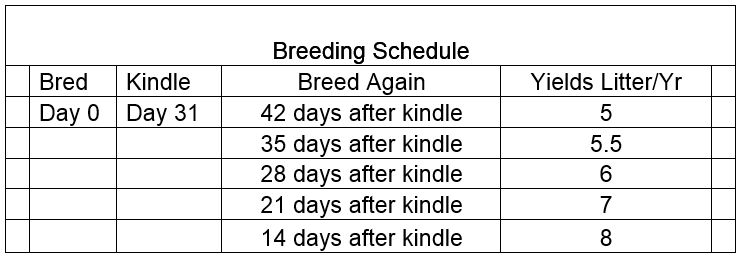
The twenty-eight to forty-two days schedules are less demanding, both on your breeders and your management, but they produce less pounds of meat per year and higher FCR. Does that are bred sooner than the fourteen day schedule aren’t able to recuperate and each successive litter becomes weaker and less viable. Does allowed to go beyond the forty-two day schedule during breeding season become markedly more difficult to breed in the future and less likely to have successful litters.
With proper breed selection and, careful record-keeping, thoughtful care, and judicious culling, it’s possible to provide a nutritious, reliable meat source with minimal investment and monetary risk to your homestead.

